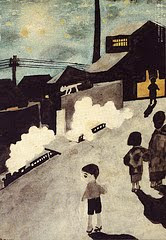This evening, riding the rust-tarnished mama cruiser bike down a road in Buzen’s city-center I caught a glimpse of a storefront revealing beautiful wares. I stood and stared for a moment. I saw a woman come out from behind a curtain to the back counter. When she saw me I remounted and peddled on a little further down the road. I parked the bike and returned to the shop. Inside I found this shop sells pottery, specializing in cups to drink tea from. In Japanese these cups are called Chawan. I asked the owner if I could look around. She told me -Yes, please do, and afterwards she would like to prepare tea for me.
After a minute or so of looking, the owner returned from the back and told me she would like to tell me a about the pottery.
-This is Arita pottery with its beautiful floral patterns painted in the thinnest of paints. In the front there is an area for pottery painted red. This section is intended for people turning 60 years old. Traditionally this age marks the beginning of a second life for people in Japan. The red color is thought to encourage renewed energy and happiness.
Coincidentally, I kn ow of another person who is turning 90 years old tomorrow. I wonder about the significance of that age. There were many different types of pottery, from many different parts of the country. The piece I remember best is a cup with a glittering surface and an earthen color complimented by lilac and crimson highlights. Absolutely beautiful.
ow of another person who is turning 90 years old tomorrow. I wonder about the significance of that age. There were many different types of pottery, from many different parts of the country. The piece I remember best is a cup with a glittering surface and an earthen color complimented by lilac and crimson highlights. Absolutely beautiful.
While sitting at the back counter I asked for the owner's name, but instead she gave me the business card for the shop. The store is called Kozuchi, named after the magic hammer from the Japanese tale of Issun-boshi, the one-inch boy. I didn’t understand at the time the significance of the name. When she showed me a hammer she had in the shop, I told her it seems like a child’s toy. Now I’m somewhat embarrasses by the way I responded, but she is kind and smart and smoothed it over.
At the back counter, I was given a tray holding a cup of Kombucha with Pickled Plum, a short block of thick Grape jelly, and a traditional Japanese snack filled with granulated sugar. Drinking this tea and eating these snacks was the perfect thing for me after work. The music playing was Music Box meets the Japanese song. Nothing about the tea, the snacks or the shop itself seemed exotic to me. While at the same time, I know this shop contains some kind of magic.
Kozuchi is open from 12:00~ 7:00pm on Fridays and Saturdays. It is located between the Buzen Fukuoka Bank and The Marushoku Sunlive Grocery Store.





